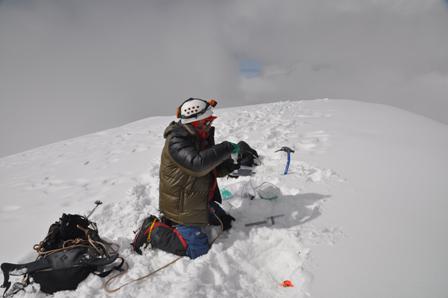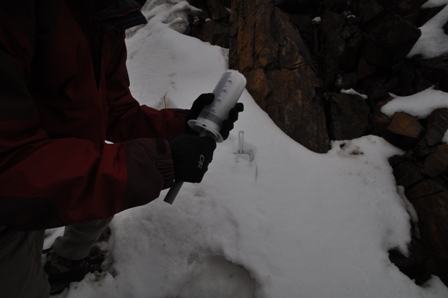Mountains are climbed year round and each season climbers, both professional and amateur, clamber up the world's most remote and popular peaks for a chance to summit. Unfortunately, not all of these expeditions are as exploratory, or purpose-driven as they should be and few times do these excursions have a defined scientific data-gathering purpose. A summer 2011 expedition's purpose is to collect snow samples from the mountaintops and glaciers themselves, and to apply these findings to current environmental research.
This June, 18 volunteers, scientists and mountaineers from the US and Canada will traverse the lofty mountain peaks of Peru in order to better understand our air quality. The American Alpine Club CBEE2011 expedition, will take place in Huaraz, Peru, close to the Cordillera Blanca range; a massive collection of mountains, glaciers and alpine lakes. Here there are over 100 mountains above 6000m (19,685ft); among the world's highest. Data gathered from this expedition will be analyzed and used to determine the quality of the air we breathe, and applied to ongoing climates studies and research.
CBEE 2011 Link: http://www.americanalpineclub.org/p/cbee2011
Recently I spoke with Frank Nederhand, the expedition science director, about the excursion.
Chadwick: Frank, explain the terrain of the Cordillera Blanca and Santa Cruz area?
Frank: The tallest mountains in the tropics, the Cordillera Blanca of Peru, have been chosen because of their fragile nature and significance. Do you realize that in North America we only have 11 peaks higher than 5000 meters. The Cordillera Blanca has over 100! Accessing the tops of these babies needs to be done by us mountaineers. I think it's awesome that the AAC is willing to embark on this type of expedition and help us mountaineers to do it.
Chadwick: Frank, what is the overall objective of this expedition?
Frank: To have a blast climbing? ...No seriously... as mountaineers in the USA we take for granted that our mountains are protected from the impacts of human activity such as air pollution, or at least we know that our government and scientists routinely monitor our mountains to determine any impacts that they may have on them so that regulatory policy can be made to deal with impacts.
It turns out that Peru (like many developing countries) is trying their best to catch up with North America and Europe in managing their environment.
Peru also contains one of the most precious of jewels of mountain ranges, they have the highest mountains found anywhere in the earth's tropical zone. These high mountains are the magical and beautiful Cordillera Blanca (White Mountains) of the Ancash Region of Peru.
The American Alpine Club is helping us take a bold step and jump start the Peruvian government's efforts to monitor these mountains for air pollution impacts. Peru has already set aside the Cordillera Blanca as a national park. What the Alpine Club is proposing to do is use its most valuable asset, the climber scientist, to perform an air pollution impact study similar to what is performed on a routine basis in the USA, but to do it in the Cordillera Blanca. It is recognized as a worldwide heritage site. Snow melt from the Cordillera Blanca has provided Peru with its year-round water supplies, while 80% of Peru's power comes from hydroelectricity. Most critical, the area of permanent ice pack shrank by about a third between the 1970s and 2006. We will share this effort with the local mountaineering professional community and land managers so that they can do this monitoring themselves. We can share this effort with the local mountaineering professional community and land managers so that they can do this monitoring themselves.
Chadwick: So, after the snow samples have been collected and you have them at base camp, how will the samples and scientific data be shared?
Frank: The AAC does a great job of providing information on its website, www.americanalpineclub.org. Some of the data will be available that way. The AAC may include the trip report and even the results in the American Alpine Journal. Moreover, we will be sharing the scientific results with the Peruvian Government and an important partner, The Mountain Institute, www.mountain.org (The Mountain Institute). They have been doing many worthwhile scientific research programs to benefit the local communities and we have an initiative with them, the Alpine Conservation Partnership. Last, we will share it with the scientific communities. We will also do rudimentary climate change work as well. We have some folks from academia helping us with that aspect of our planning. I am sad to report that glacier recession is really hurting these mountains, hopefully we can help with providing scientific information to help the Peruvians understand what the global warming impacts are.
Chadwick: Is this a one-off of project, or more a long term goal? This type of project seems like it would benefit from ongoing research.
Frank: This is a long term project... human kind is ever increasingly impacting high mountains and Peru is just one place of many that needs this type of monitoring so as long as there are mountaineer scientists that care about the mountains there will be plenty of work to do , in fact it's kind of overwhelming in a way.
Chadwick: How will the information be gathered?
Frank: Well Chad, it's a complex process but the core thing we, as mountaineers, will be doing is collecting snow and ice samples from the glaciers on the peaks that we will be climbing during the expedition. Mountaineers will climb with Peruvian mountain guides, chosen for their willingness to help and learn the science of air pollution monitoring on the high peaks of the Andes.
Local university students and Huascaran National Park staff will accompany the expedition where they can as well. The core methodology to determine air pollution impacts will be snow and ice samples collected at designated locations and elevations to provide both a horizontal as well as a vertical profile of the mountain range. Ten key mountains have been identified for this sampling. These samples will be analyzed for key micro elements using ICP-MS and other appropriate methods. One of the most important environmental air pollutants to be measure will be mercury.
Depending on the generosity of the climbing and environmental communities we may be able to do a lot more than just these passive techniques. We would like to bring active sampling equipment as well. We will have local Peruvian involvement -- 9 teams of three mountaineers, each one of them will include a local cimber, and maybe more. We want to provide training if at all possible as well. We will be working closely with the Huascaran Park Service staff and we will have their chief scientist, Dr. Ricardo Ramiriez participating with us.
"The high altitude ice on our planet holds extraordinary fresh water resources in places to which climbers have unique access. These are the water towers of our world. Climber scientists play a special role collecting data from locations that house key early indications of the effects of climate change but are very difficult to access." - Phil Powers, Executive Director, American Alpine Club
Chadwick: What type of support does this expedition currently have?
Frank: Financially? Very little... this is the beginning chapter. We have a budget and we need $75,000 for scientific equipment to accomplish our goal to field 9 teams and support supplies to do a proper study. I am confident that the climbing community will step up to the challenge I just hope that donors and the sponsors we are submitting grant applications to will do the same.
The money raised will all go towards the logistics and scientific research of the expedition. Ellen Lapham, AAC and CBEE Director, discussed the situation: "The CBEE has exemplary goals in helping a growing developing nation learn about its environment. We are raising $75,000 so that we can donate professional air quality monitoring and testing equipment. Plus, to have a lasting outcome, we are collaborating with and will be training Peruvian scientists to continue this work on Peru's spectacular high peaks. "
In the early days of mountaineering most expeditions owed their activity to scientific exploration. The reason and need to climb many of these mountains was to understand mountain geology; to explore the unknown alpine environs, or in the case of Dr. Johan Reinhard, to excavate human remains from 14th century sacrificial offerings. Climbing legend Bradford Washburn is probably one of the best historical examples of the scientist climber, his climbs were always for research and exploration and were shared with the institution he directed, Boston's Museum of Science.
The 2011 expedition is currently seeking corporate, institutional and academic affiliations. If anyone wishes to donate or join the expedition, please visit the link below, where you can contact, apply and/or donate.
AAC CBEE 2001 Enviromental Expedition Link



